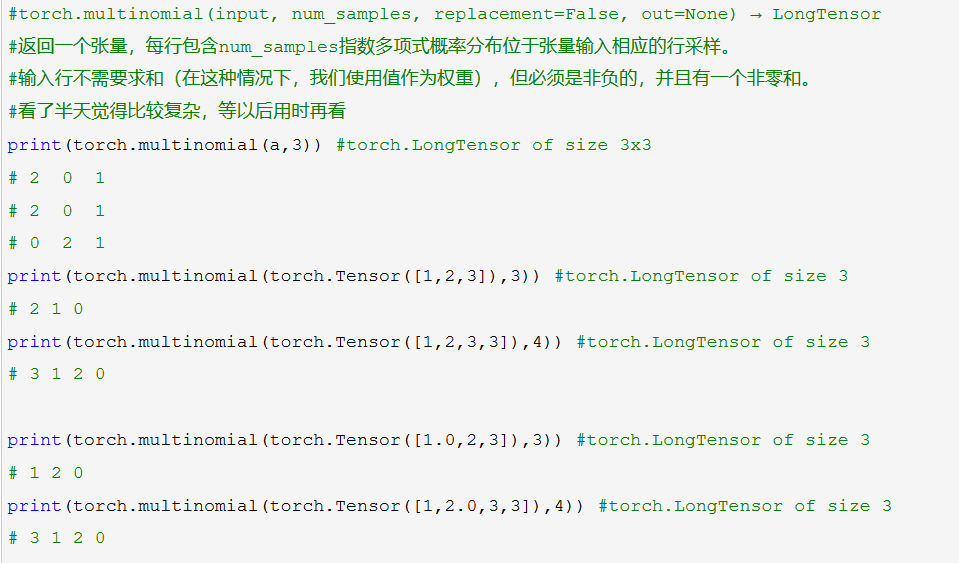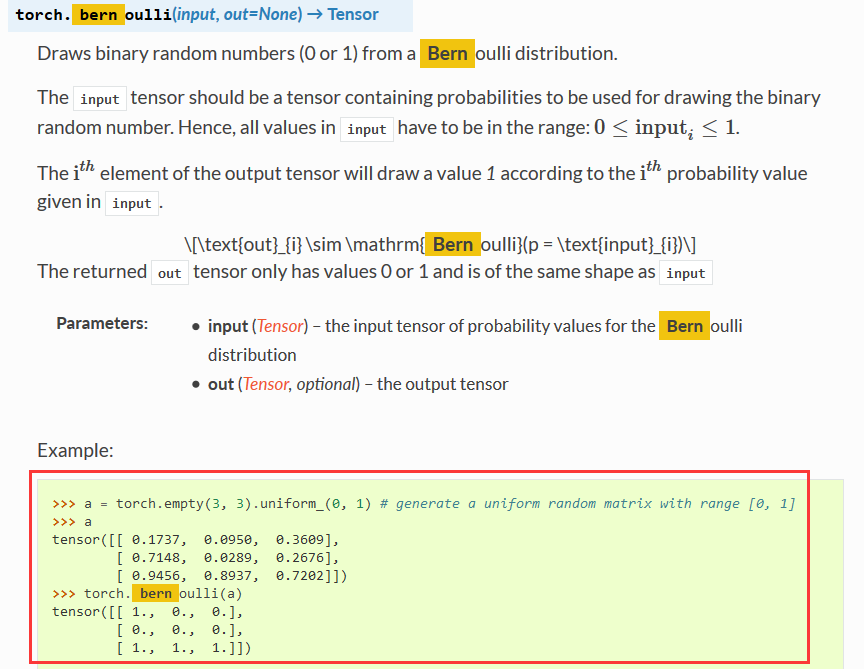问题六:
问题五:这里是怎么得到的?

问题四:为什么会是如下结果?

torch.bernoulli(a)怎么是这个结果?
问题1:torch各个类型数据格式如何转换?数据类型在官方文档torch.Tensor中,有八种类型。
#尝试一 i32=torch.IntTensor([1,2,3]) i64=torch.LongTensor([1,2,3]) #两种转换都报错#new_i64=torch.IntTensor(i64)#new_i32=torch.LongTensor(i32)#didn't match because some of the arguments have invalid types: (!torch.LongTensor!) #尝试二 new_i32=i32.long() print(torch.equal(new_i32,i64)) #True#torch.Tensor对应八种数据转换,各种数据可以相互转换 i32.float() i32.double() i32.half() i32.byte() i32.char() i32.short() i32.int() i32.long()
问题2:官方文档中sequence of tensors是什么意思?在torch.stack(sequence,dim=0,out=None).
是tensors构成的序列,可以为列表,也可以为元组。
#torch.stack(sequence, dim=0, out=None) 连接Tensors i32=torch.Tensor([1,2,3]) print(torch.stack([i32,i32,i32])) #默认dim=0,以列为基准#1 2 3#1 2 3#1 2 3#[torch.FloatTensor of size 3x3] print(torch.stack([i32,i32,i32],dim=1)) #1 1 1#2 2 2#3 3 3#[torch.FloatTensor of size 3x3] print(torch.stack((i32,i32,i32),dim=1)) #1 1 1#2 2 2#3 3 3#[torch.FloatTensor of size 3x3]
问题3:为什么有如下Tensor格式区别?有的是size 3,有的是size4x1 ?
torch.from_numpy(np.array([1,2,3])) #torch.IntTensor of size 3
torch.from_numpy(np.array([1.0,2,3])) #torch.DoubleTensor of size 3
torch.nonzero(torch.Tensor([1,2,3,0,4]))==torch.Tensor([0,1,2,4]) #nonzero 非0元素所在位置
# TypeError: eq received an invalid combination of arguments - got (torch.FloatTensor), but expected one of:
# * (int value)
# didn't match because some of the arguments have invalid types: (!torch.FloatTensor!)
# * (torch.LongTensor other)
# didn't match because some of the arguments have invalid types: (!torch.FloatTensor!)#注意上面代码中两者数据格式类型不一致,torch.FloatTensor torch.LongTensor
#torch.unsqueeze(input,dim,out=None)
m=torch.Tensor([1,2,3,4])
print(m) #torch.FloatTensor of size 4
m_zero=torch.unsqueeze(m,0)
print(m_zero) #torch.FloatTensor of size 1x4
m_one=torch.unsqueeze(m,1)
print(m_one) #torch.FloatTensor of size 4x1
m_zero_to_m=torch.squeeze(m_zero)
print(m_zero_to_m) #torch.FloatTensor of size 4
print(m==m_zero_to_m) #torch.ByteTensor of size 4
# 1
# 1
# 1
# 1
print(m.equal(m_zero_to_m)) True
可见为两种不同数据类型,可以通过unsqueeze和squeeze来相互转化。判断两个Tensor是否相等,用equal
问题4、